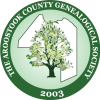1790
Especially in the earlier censuses look at who the neighbors are. You may find other relatives. People probably didn’t travel very far to find a spouse. Only the head of the household was named though.
1800
The census breaks down the family into more age groups. Sometimes the list was put in alphabetical order so you don’t know who the neighbors were. Don’t forget name spellings were all over the place. Names were spelled phonetically and some people didn’t know how to spell their own names. If nobody was at home the census taker may have asked the neighbors so the information may be really wrong. This happened even in the 1940 census.
1810
There were some manufacturing schedules that may be of some help.
1820
Free white males age group 16-18 was added. Do not add the number in this age group to the family total. They were counted twice. The government needed this for military purposes. There is now a naturalization column. Maybe this will give you an idea how long people have been here.
1830
Deaf, dumb and blind have now been added. You may need to look for records of hospitals, institutions and schools.
1840
There is a separate listing for Revolutionary War pensioners. Now you may need to search for military records, pension records and bounty or land grants.
1850
Finally!!! Everyone has a name. You may be able to now work backwards using an earlier census. Occupations are listed and there is also a mortality schedule for those who died in the last year with a cause of death.

